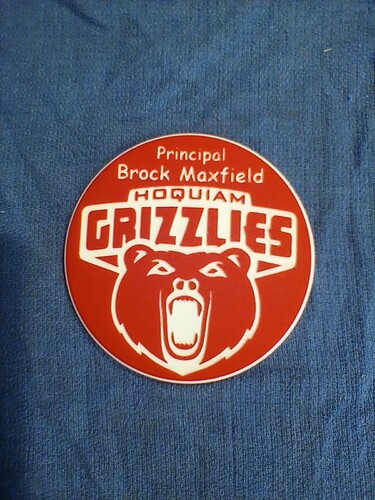First time post. Thanks to all of you for the many questions and answers I have been reading the last few weeks.
I am a volunteer in the metal shop at Hoquiam (WA) High School and I am trying to cut some fine detail in some drink coasters. The material is the two color HDPE from the carbide store. I am using a 1/32 ball end mill for the fine detail at the default settings of F30.0 in/min & S10000rpm. The chips are not flying out of the cut…they seem to be melting together into a snarl in the kerf. I was thinking of increasing the feed to decrease heat buildup in the cut. Any advice greatly appreciated!
Haven’t run a ball that small on HDPE. But I’d imagine getting good results with it will be difficult. HDPE is quite soft, and requires a decent cut. Do you have to use a ball? Color Core is used extensively in my industry. Most commercial stuff is done with a typical single flute, single flute engraving mill with a decent tip diameter, and occasionally a reasonably sized ball. I don’t recall ever seeing something particularly detailed.
Thanks for sharing your experience. I don’t have an engraving bit, so I will try playing with the feed. If that yields no joy, another material may be the answer. Be well.
Disclaimer: I have never used a 1/32" ball endmill in HDPE either, however I’ll say that whenever I have had issues when not making well-formed chips while cutting plastics (especially HDPE), the answer as always been “feed faster” for me.
30ipm at 10.000 on what I assume is a two-flute endmill grants a chipload of 0.0015".
For 1/16" I would use a 0.002’‘–0.003’’ chipload as a starting point, so on a 1/32" that 0.0015" value makes sense, still you could try to use the feedrate override during a test cut to see if bumping it by increments of 10% improves things. I would do this test while also reducing depth of cut by 50%, for the sake of keeping tool deflection to a minimum and not take any chances with such a fragile tool.
FWIW, here’s a thread where I used a 1/16" endmill in C3D’s two-color HDPE, which turned out super clean:
I’m with @Lowbrowroyalty : if you can buy your way out of this problem, consider getting another endmill.
If I had to do it and a 1/32" was mandatory, I would pick something like this :
Thanks again for all the advice. I scaled up my design so I could use a 1/16" flat end mill to rough out the pockets. Then I used a 1/32" ball to cut the fine detail. I increased the feed by 50% and decreased depth of cut by 50%. I also decreased the stepover on the 1/32nd ball from 0.016 to 0.008". I was very happy with the result. I spent about 15 minutes with a dental pick to release some plastic fuzz hanging around in the fine detail.
This topic was automatically closed 30 days after the last reply. New replies are no longer allowed.
